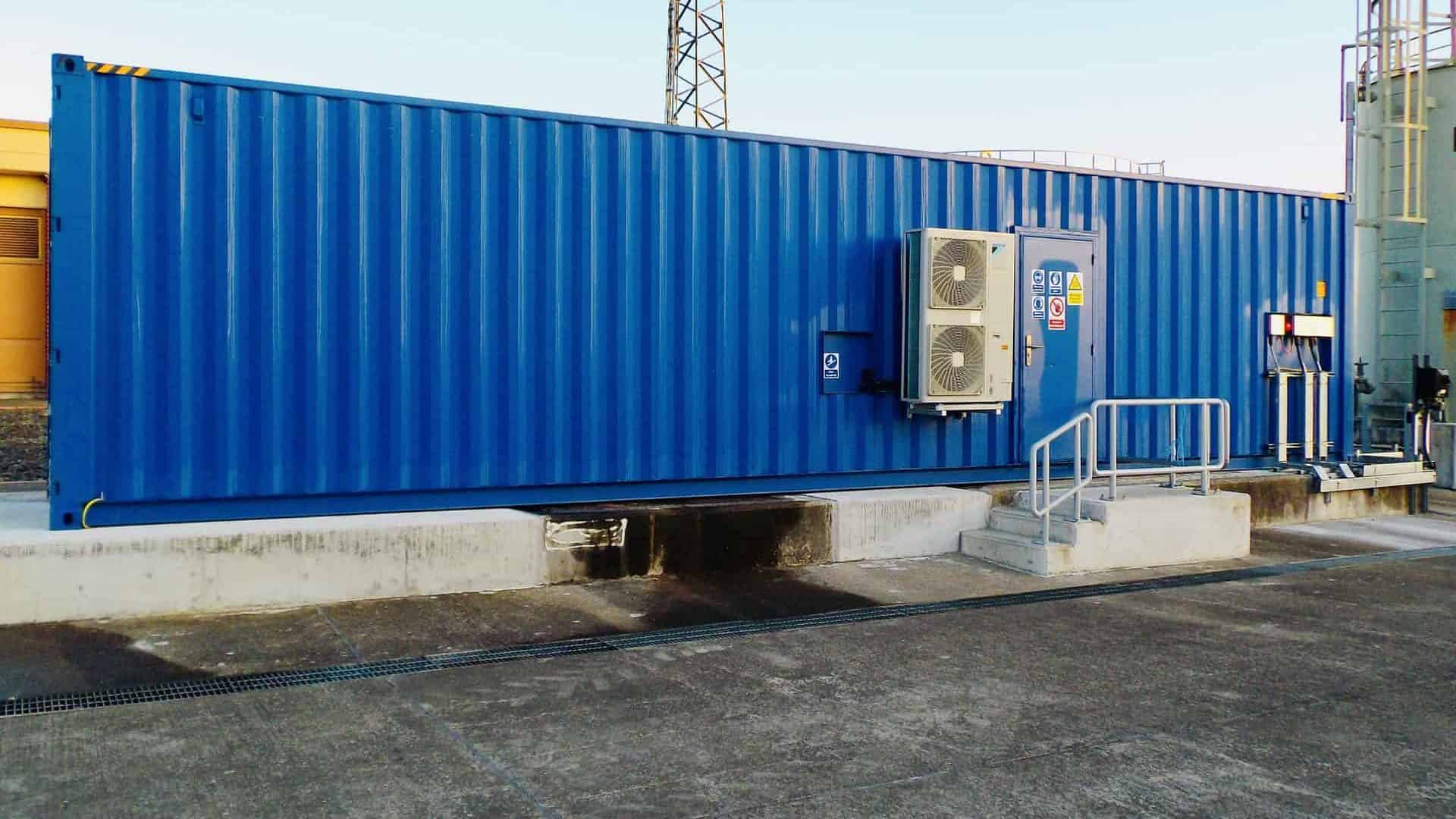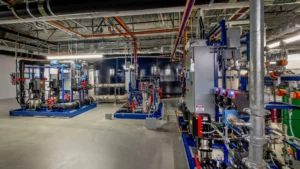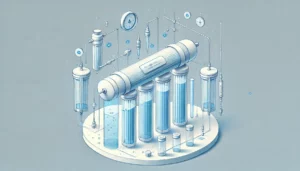There are many benefits to working with Wychwood Water Systems to design and build a complete water treatment system within an ISO shipping container. Having worked on numerous containerised water treatment systems, there are several common questions our clients usually ask:
What Type of Container Should be Used for a Water Treatment System?
The container is normally a single-use unit loaded only once in the journey from the country of original manufacture. The containers are of a standard design and are manufactured from corrosion-resistant Corian steel.
What Options are Available for Containerised Water Treatment Systems?
By converting the container for its new use, there are many options available:
- Pedestrian access door – the door is steel with a small glazed panel and commercial grade lock. The door is normally mounted in the sidewall of the container to provide pedestrian access without the need to open up the main container loading doors.
- Paint finish – the external paint finish of the container is normally left as the original paint finish with any fabrication changes made during the conversion overpainted in the original paint finish.
- Recessed flange plates can be installed in the sidewall to form a connection joint for all inlet and outlet water services.
- Electrical terminal boxes for all power and signal cables can also be mounted on the side walls.
- Insulation – internally the proven approach is to insulate the walls and ceiling with mineral wool. These internal surfaces are then clad in 12mm marine ply before sealing and decorating in an acrylic paint finish.
- Flooring – the floor of the containers as standard already has a 32mm ply layer. As part of the conversion, this is coated and sealed in industrial-grade vinyl.
- Lighting – industrial-grade strip lighting can be installed in the ceiling with two switch points installed by the pedestrian and loading doors.
The complete installation and the pre-commissioning of the containerised water treatment system can be finalised and tested at the factory before the final result is shipped to you.
What Are the Benefits of These Water Treatment Systems?
The benefits of this approach are considerable:
- You do not need to build a plant room – all that is required is a hard standing.
- The container can be craned into difficult locations or even stacked to save space.
- You can inspect and test the complete package before it is shipped to the site
- Installation and commissioning are kept to an absolute minimum.
This containerised approach is also very practical for export situations where the complete finalised package can be shipped overseas.
Containerised Water Treatment System Advice And Design
One thing is very clear, there is no substitute for good advice from a specialist company when considering the installation of a water treatment system.
For the best advice on water treatment systems relevant to your industry, or to request a FREE water treatment site assessment, please contact one of our experts at Wychwood Water Systems today and we will arrange to visit your premises and offer tailored advice depending on your needs.
To find out more about what Wychwood Water Systems can do to help, including the designing, manufacturing, installing & commissioning, servicing, and refurbishment of water treatment systems, view our services to find the ideal water treatment solution for you.
Bonus: How To Maximise Your Water Treatment Plant Efficiency
Better efficiency means increased productivity. However, water can be a bit of a slippery customer. It tends to go where it wants, resulting in water loss. The outcome is a range of inefficiencies, many of which can be deeply frustrating. If you’re concerned about losing water from your water treatment plant, read on.
What Is Water Loss?
There are two main types of water loss. The first is ‘apparent loss’. This refers to metrical inaccuracies that give false readings regarding water usage. Antiquated systems, data errors, and poor servicing are the primary culprits for apparent loss. The second type of water loss is ‘real loss’.
This means water that is lost due to leakage or overflows. Most companies are more concerned about real loss because escaped water can be highly damaging to equipment, buildings, and land. If the lost water has already been treated, it also represents a waste of investment.
Why Should I Be Interested In Reducing Water Loss?
Water loss is expensive. Over three billion litres are lost across the UK every day, and Ofwat – the economic regulator of the water sector in England and Wales – is a powerful taskmaster when it comes to taking action against companies. Aside from being a financial drain, water loss from treatment plants can be costly in other ways.
With climate change and the global food crisis now becoming very hot topics, reducing water wastage and increasing corporate sustainability is likely to become even more heavily regulated. Corporate Social Responsibility (CSR) influences brand identity, and therefore getting the ecological footprint wrong can result in a long-lasting PR dent and the loss of contracts. Prevention is always better than a cure, so minimising wastage has a wide range of long-term cost benefits.
How Can I Control Apparent Losses?
Meters and software systems need to be regularly serviced. Meters are notoriously prone to losing accuracy, and many water treatment companies forget this invisible – yet expensive – issue. When combined with out-of-date data handling methods, the result can be a very misleading picture.
Data-handling issues tend to have their roots in human error, but legacy software can also be culpable. However, when a measurement is articulated as a priority and is fully risk-assessed, apparent losses are minimised. This helps with strategic planning and prevents unnecessary criticism from Ofwat.
How Can I Control Real Losses?
Real losses tend to escape unnoticed until the situation reaches a critical point. This potentially deadly eventuality was captured on CCTV in 2017. The video shows a woman walking calmly down a street moments before the tarmac erupts like a liquid volcano, with surrounding roads quickly turning into rivers. Thankfully, leakage management is a very dynamic area of academic research, so solutions are becoming available. These begin with having the right equipment in place and keeping it serviced. This means sourcing reliable parts and using preemptive maintenance. This can be combined with prioritising speedy repairs, which prevents any issue from getting out of hand.
Sonar testing can be used to monitor the condition of underground pipes, whilst pressure management is important for preventing explosive pipe bursts. Controlling pressure can also limit unnecessary wear and tear on joints and valves, so is a good way of prolonging the health of a system and reducing downtime.
From financial reasons to CSR, every company requires water efficiency. For more information, please don’t hesitate to get in touch with our team of water treatment experts.





